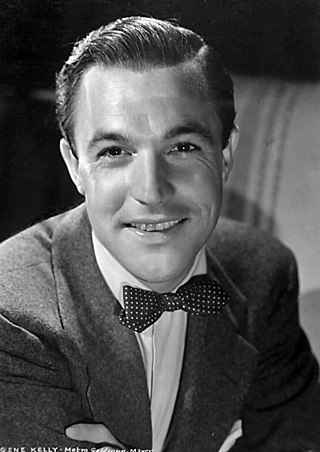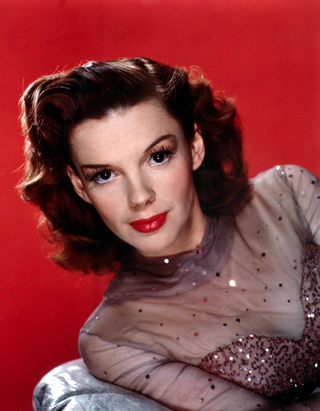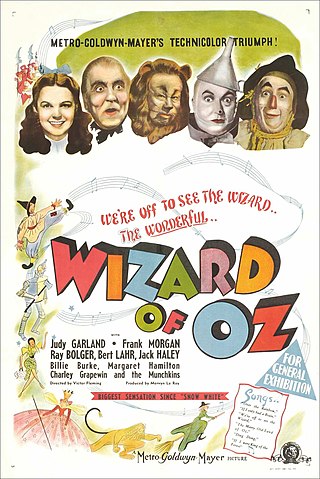
Eugene Curran Kelly was an American dancer, actor, singer, director and choreographer. He was known for his energetic and athletic dancing style and sought to create a new form of American dance accessible to the general public, which he called "dance for the common man". He starred in, choreographed, and, with Stanley Donen, co-directed some of the most well-regarded musical films of the 1940s and 1950s.

Judy Garland was an American actress, singer, and vaudevillian. Renowned for her powerful contralto voice, emotional depth, and versatility, Garland rose to international fame as Dorothy Gale in The Wizard of Oz (1939), a role that cemented her status as a Hollywood legend.

The ruby slippers are a pair of magical shoes worn by Dorothy Gale as played by Judy Garland in the 1939 Metro-Goldwyn-Mayer musical film The Wizard of Oz. Because of their iconic stature, they are among the most valuable items of film memorabilia. Several pairs were made for the film, though the exact number is unknown. Five pairs are known to have survived; one pair was stolen from a museum in 2005 and recovered in 2018.

Ann Miller was an American actress and dancer. She is best remembered for her work in the classical Hollywood cinema musicals of the 1940s and 1950s. Her early film work included roles in Room Service with the Marx Brothers and Frank Capra's You Can't Take It with You, both released in 1938. She later starred in the musical classics Easter Parade (1948), On the Town (1949) and Kiss Me Kate (1953). Her final film role was in Mulholland Drive (2001).

The Wizard of Oz is a 1939 American musical fantasy film produced by Metro-Goldwyn-Mayer (MGM). Based on the 1900 novel The Wonderful Wizard of Oz by L. Frank Baum, it was primarily directed by Victor Fleming, who left production to take over the troubled Gone with the Wind. It stars Judy Garland, Frank Morgan, Ray Bolger, Bert Lahr, Jack Haley, Billie Burke, and Margaret Hamilton. Noel Langley, Florence Ryerson, and Edgar Allan Woolf received credit for the screenplay, while others made uncredited contributions. The music was composed by Harold Arlen and adapted by Herbert Stothart, with lyrics by Edgar "Yip" Harburg.

Cyd Charisse was an American dancer and actress.

Easter Parade is a 1948 American Technicolor musical film directed by Charles Walters, written by Sidney Sheldon, Frances Goodrich, and Albert Hackett from a story by Goodrich and Hackett, and starring Judy Garland, Fred Astaire, Peter Lawford, and Ann Miller. The film contains some of Astaire's and Garland's best-known songs, including "Easter Parade", "Steppin' Out with My Baby", and "We're a Couple of Swells", all by Irving Berlin.

That's Entertainment! is a 1974 American compilation film released by Metro-Goldwyn-Mayer to celebrate the studio's 50th anniversary. The success of the retrospective prompted a 1976 sequel, the related 1985 film That's Dancing!, and a third installment in 1994.

The Harvey Girls is a 1946 Technicolor American musical film produced by Arthur Freed for Metro-Goldwyn-Mayer. It is based on the 1942 novel of the same name by Samuel Hopkins Adams, about Fred Harvey's Harvey House waitresses. Directed by George Sidney, the film stars Judy Garland and features John Hodiak, Ray Bolger, and Angela Lansbury, as well as Preston Foster, Virginia O'Brien, Kenny Baker, Marjorie Main and Chill Wills. Future star Cyd Charisse appears in her first speaking role on film.

An American in Paris is a 1951 American musical romantic comedy film inspired by the 1928 jazz-influenced symphonic poem An American in Paris by George Gershwin. Starring Gene Kelly, Leslie Caron, Oscar Levant, Georges Guétary, and Nina Foch, the film is set in Paris, and was directed by Vincente Minnelli from a script by Alan Jay Lerner. The music is by George Gershwin, with lyrics by his brother Ira, with additional music by Johnny Green, and Saul Chaplin, the music directors.
"That's Entertainment!" is a popular song with music written by Arthur Schwartz and lyrics by Howard Dietz. The song was published in 1952 and was written especially for the 1953 Metro-Goldwyn-Mayer musical film The Band Wagon. The song is performed in the film by Jack Buchanan supported by Fred Astaire, Nanette Fabray, and Oscar Levant. In 2004, the song finished at number 45 in AFI's 100 Years...100 Songs survey of top tunes in American cinema. It was orchestrated for the film by Conrad Salinger under the musical direction of Adolph Deutsch.

Little Nellie Kelly is a 1940 American musical-comedy film based on the stage musical of the same title by George M. Cohan which was a hit on Broadway in 1922 and 1923. The film was written by Jack McGowan and directed by Norman Taurog. Its cast included Judy Garland, George Murphy, Charles Winninger and Douglas McPhail.
Roger Edens was a Hollywood composer, arranger and associate producer, and is considered one of the major creative figures in Arthur Freed's musical film production unit at Metro-Goldwyn-Mayer during the "golden era of Hollywood".

Ziegfeld Follies is a 1945 American musical comedy film released by Metro-Goldwyn-Mayer (MGM), primarily directed by Vincente Minnelli, with segments directed by Lemuel Ayers, Roy Del Ruth, Robert Lewis, and George Sidney, the film's original director before Minnelli took over. Other directors that are claimed to have made uncredited contributions to the film are Merrill Pye, Norman Taurog, and Charles Walters. It stars many MGM leading talents, including Fred Astaire, Lucille Ball, Lucille Bremer, Fanny Brice, Judy Garland, Kathryn Grayson, Lena Horne, Gene Kelly, James Melton, Victor Moore, William Powell, Red Skelton, and Esther Williams.

The Pirate is a 1948 American musical film produced by Metro-Goldwyn-Mayer. It stars Judy Garland and Gene Kelly with costars Walter Slezak, Gladys Cooper, Reginald Owen, The Nicholas Brothers, and George Zucco, with music by Cole Porter.

Summer Stock is a 1950 American Technicolor musical film produced by Metro-Goldwyn-Mayer. It was directed by Charles Walters, stars Judy Garland and Gene Kelly, and features Eddie Bracken, Gloria DeHaven, Marjorie Main, and Phil Silvers. Musical numbers were staged by Nick Castle and Kelly.

Thousands Cheer is a 1943 American musical comedy film directed by George Sidney and released by Metro-Goldwyn-Mayer. Produced during the Second World War, the film was intended as a morale booster for American troops and their families.

Presenting Lily Mars is a 1943 American musical comedy film directed by Norman Taurog, produced by Joe Pasternak, starring Judy Garland and Van Heflin, and based on the 1933 novel by Booth Tarkington. The film is often cited as Garland's first film playing an adult role. However, the issue is complicated by the delay in this film's release caused by reshooting the finale, and Garland's brutal work schedule—she was filming Girl Crazy and For Me and My Gal at the same time. Also, in Little Nellie Kelly, released in 1940, she plays her character's mother, dying in childbirth. Tommy Dorsey and Bob Crosby appear with their orchestras in this Metro-Goldwyn-Mayer production.

For Me and My Gal is a 1942 American musical film directed by Busby Berkeley, and starring Judy Garland, George Murphy, Martha Eggerth, Ben Blue and Gene Kelly in his film debut. The film was written by Richard Sherman, Fred F. Finklehoffe and Sid Silvers, based on a story by Howard Emmett Rogers inspired by a true story about vaudeville actors Harry Palmer and Jo Hayden, when Palmer was drafted into World War I. The film was a production of the Arthur Freed unit at MGM.
Tom C. Keogh was an international fashion illustrator, graphic artist, and set and costume designer who married dancer and novelist Theodora Keogh, née Roosevelt, the granddaughter of President Theodore Roosevelt. Born in San Francisco, Tom Keogh studied at the California School of Fine Arts and the Chouinard School of Painting. In 1944 he moved to New York to work as an illustrator for Barbara Karinska, the theatre, ballet and film designer. After their wedding the Keoghs moved to Paris.

















